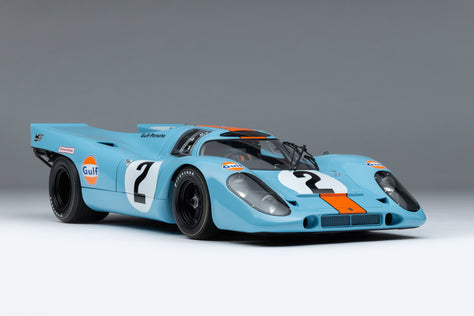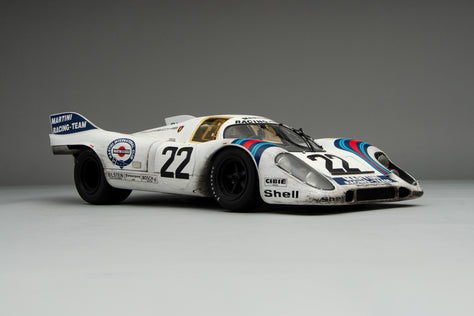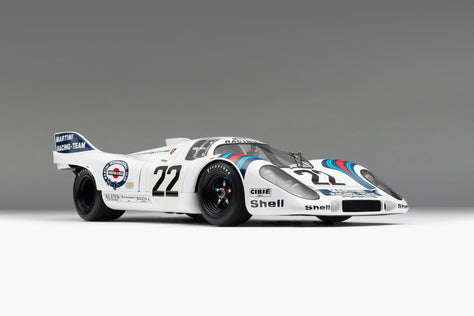Technical Details
- Description
- Scale guide
We are thrilled to offer a special edition of ten race weathered Porsche 917Ks, as raced to victory by Pedro Rodríguez and Jackie Oliver at the 24 Hours of Daytona on the 30th and 31st of January 1971. This unique edition of only ten models has been meticulously hand-painted and detailed by our master model makers to show every detail of the race dirt and damage as the car drove to victory. Each of the ten models will be accompanied by an archive quality Giclée print of the car mid-race, selected by the curator at Motorsport Images.
Arguably one of the most iconic race cars in the history of motorsport, the Porsche 917’s conception stemmed from an unexpected change to Commission Sportive Internationale, then the independent competition arm of the FIA, sanctioning rules. After the 1967 race season, it was announced that all future prototype engines would be limited to 3.0 litres, in order to reduce the speeds generated at the fast endurance tracks, whilst also enticing manufacturers who were already building three-litre Formula One engines into endurance racing. Well aware that few manufacturers were up to the challenge immediately, the CSI also announced a new Group 4 sports car series, which allowed engine displacements of up to 5.0 litres, but required at least 25 units be produced for homologation. Porsche, already hard at work polishing its 3.0-litre race car, the 908, stunned the world when it unveiled a second prototype race car aimed at the Group 4 category: the 917. Despite the FIA’s doubts, Porsche presented the FIA with 25 units just three weeks after the 917’s debut at the Geneva Motor Show in March of 1969.
Powering the early 917 was a 4.5-litre Flat-12 engine, designed by the noted Porsche engineer Hanz Mezger. To curtail development costs, the engine borrowed heavily from its 3.0-litre counterpart found in the Porsche 908. The 1969 race engines produced 580 bhp and 376 lb-ft of torque. Later models had the option to run larger-displacement engines of 4.9, 5.0 and eventually 5.4 litres, each providing a corresponding bump in performance. The Flat-12 would go on to become the 917’s most defining trait.
While the engine was an immediate success, the car’s body and aerodynamics were anything but. Early tests were worrisome. The car wandered heavily under braking and was diabolical in high-speed turns. None of the regular Porsche drivers wanted to race it. But the engineers at Porsche soldiered on, eventually adding wider rear wheels and a few other changes that made the 917 into a more controllable machine. Short and long-tail versions of the car were developed, but while the 917 long-tail is a thing of beauty, the shape made famous by a flurry of victories is the short version, better known as the 917K, for “Kurtz.”
The 917K did not have to wait long for success. On its public debut at the 1970 Daytona 24 Hours, John Wyer's Gulf-sponsored team finished 1-2 in the race, with the winning car breaking the distance record by 190 miles. This victory effectively began the 917K's domination of the World Sportscar Championship for the next two seasons. Porsche’s first overall victory at the 24 Hours of Le Mans soon followed, a momentous occasion for the German marque, but only one of many more to follow. Triumphs that year came quickly and resoundingly and, in total, the 917K’s first full year of competition would bring seven major victories. 1971 was no different, with six major victories topped by another overall win at Le Mans. Later that year, development of the Can-Am version would start, a car so dominant that the series lost popularity in the United States, never to return.
Today, the 917K is revered as one of the most iconic race cars of all time. It was the car that brought Porsche its first overall victory at the world’s most gruelling race, and the car that would go on to set one of the most impressive records of dominance in prototype racing series the world has ever seen. If its racing achievements alone were not enough, the car would go on to be immortalized on the big screen by Steve McQueen in the film ‘Le Mans'.
This fine 1:8 scale model of the Porsche 917K is based on the #2 car driven to victory by Pedro Rodríguez and Jackie Oliver in the 24 Hours of Daytona at Daytona International Speedway on 31st January 1971. No works teams entered this year, though the four cars entered by the John Wyer and Martini International teams were supported directly by Porsche, meaning a host of privately entered Ferrari 512s lined up to compete against the 1970-dominating 917 for the race. Rodríguez and Oliver lined up second on the grid, behind Mark Donohue and David Hobbs in the Penske-White Ferrari 512M.
The Donohue/Hobbs car held their lead for the early stages of the race, before starting to experience mechanical difficulties. In the meantime, the #2 Porsche was running smoothly and, once it had seized the lead, they extended it consistently for the vast majority of the race. With just three hours remaining, the 917 was a phenomenal 213 miles ahead of the second place NART Ferrari 512S of Tony Adamowicz and Ronnie Bucknum. However, disaster struck with the car’s transmission giving up, forcing Oliver to coast off the high banks and down to the Porsche pit with the gearbox stuck in top gear. Under normal circumstances this would be a simple repair since they had plenty of time, however, a rules change by the FIA now prevented this, leaving very little time to rebuild the transmission. The team mechanics performed a feat of miracle engineering, and the car returned to the track just 92 minutes later in the hands of Rodriguez. The Mexican emerged second with under two hours to go, behind the Adamowicz/Bucknum Ferrari and with the recovering Dononue/Hobbs Ferrari coming up fast behind. Only 33 minutes later, Rodriguez passed the lead Ferrari to recapture the lead, though a brief rain shower shortly after forced the Porsche into the pits twice, first for wet tyres and then back onto the slicks as the track quickly dried. The Adamowicz/Bucknum Ferrari stayed out on track as the Porsche pitted, retaking the lead while the #2 was stationary. Once back on the track with new slicks, Rodriguez chased down his rival, beating the Ferrari to the chequered flag by just over a lap, recording the closest ever finish at a Daytona 24 Hours race at that time, after travelling over 2620 miles (4218km) at an average speed of 109.2mph (175.7km/h). The duo’s victory would contribute to Porsche’s maximum points haul in the season’s World Sportscar Championship, dominantly winning both the International Championship for Makes and International Cup for GT Cars for the third successive year.
This model has been handcrafted and finished in our workshops with the co-operation and assistance of Porsche regarding original finishes, materials, archive imagery and drawings. The use of supremely accurate digital scanning of the original car has allowed us to perfectly recreate every detail at scale. Furthermore, it has undergone detailed scrutiny by both engineering and design teams to ensure complete accuracy of representation.
The Porsche 917K Daytona 1970 Race Weathered Edition is limited to just 10 pieces.
Handling Race Weathered Models
Please note that Amalgam’s weathered models are incredibly fragile and require careful handling. We recommend you keep handling to a minimum to avoid removing the weathered effects from the model. When handling the model, please adhere to the instructions included with the product when purchased.
--------------------------------------------------------------
Elevate your 1:8 scale collection with one of our elegant, harmonious and handcrafted display cabinets, stands or plinths.
View Display Cabinets for this model >
This model is just one of several 1:8 and 1:8 scales in the Porsche 917 Collection.
Pre-order
Bespoke
In order for us to create your bespoke model, you will need to choose 4 extra options. Paint colour, interior colour, wheel style and caliper colour.
Please complete the form and a member of our Sales Team will contact you.
Contact Us
Please contact us for more information about ordering this model.


![[hide-in-gallery]](http://www.amalgamcollection.com/cdn/shop/files/Heroimagewideedit_1448e4cd-4d91-4a50-9b21-4741f0401815_2000x850_crop_center.jpg?v=1717497036)



